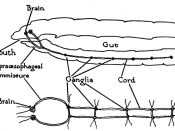~General Information~ Worms are the most complex animals that I have studied. They are classified into three different phyla. There is a small number of species(20,000) of worms but there are a large number of worms. All worms have three layers of cells. They also have true organs and organ systems, and a complex nervous system.
The Lumbricus terrestris earthworm is a segmented worm in the phylum Annelida. The earthworm is one of the most complex worms. Although segmented worms are bilaterally symmetrical like other worms, they are different because the contain a coelom (inner space filled with fluid.) Since they have a coelom, they can be called a eucoelomate. These worms are also more developed.
The earthworm is one of the best known segmented worm. It has a dark dorsal surface, and a light ventral surface. They also have an anterior end with a mouth and a small lip called the prostomium, and a posterior end with an anus.
On the skin of the worm there are bristles known as setae. Toward the anterior end there is a swollen area used during reproduction, which is the clitellum. An adult earthworm can have more than 100 segments.
Earthworms live in the soil, and they eat it as they move through it. While they make their way through the soil they leave tunnels. These tunnels are beneficial to farmers and gardeners because they allow air and water to enter the soil as they break it up.
The earthworm has several complex systems. These systems include a nervous system, digestive system, circulatory system, respiratory system, excretory system, and a reproductive system. The nervous system coordinates all movement and reactions that occur in the worm by carrying impulses over nerve pathways. The digestive system is responsible for taking in any food and...


